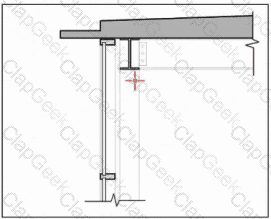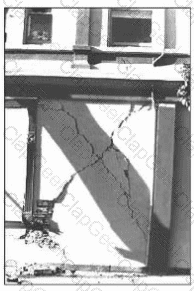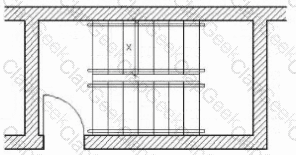An elementary school requires a renovation, selective demolition, and a major addition in order to accommodate a growing student population. An architectural firm has prepared schematic design plans incorporating the school's increased programmatic needs, including an enlarged library, cafeteria, and gymnasium; a secure courtyard; and additional space for administrative offices and classrooms. The main entrance was relocated in order to improve the traffic and pedestrian flow at the beginning and end of the school day, and additional parking was provided to comply with current zoning requirements.
The existing single-story masonry building was built in 1950. Two small additions were built later: the north addition will be kept and repurposed, but the south addition will be demolished. The building contains asbestos and lead in roof soffits, floor tiles, pipe insulation, and window paint. All existing mechanical systems need to be replaced; new systems have not been selected.
Considerations for the renovation include:
•The relocated front entrance must be easily recognizable, highly visible, and secure.
•Interior and exterior materials need to be durable and maintainable in order to withstand frequent student abuse, but also economical due to strict budget limitations.
•Good indoor air quality and increased energy efficiency are priorities for the selection of mechanical equipment.
After completion, the entire school should look uniform, without a distinctive difference between the existing building and new addition.
Building information:
•Construction Type is II-B.
The following resources are available for your reference:
•Existing Plans, including site and floor plans
•Proposed Plans, including site and floor plans
•Cost Analysis
•Zoning Ordinance Excerpts, for off-street parking requirements
•IBC Excerpts, showing relevant code sections
•ADA Standards Excerpts, showing relevant sections from the ADA Standards for Accessible Design
An elementary school library has an occupancy load of 150.
What is the minimum clear opening width required?
A new four-story apartment building is being designed on a site that has solid bedrock subsurface conditions. The client requested the lowest cost of installation, highest energy efficiency, the shortest round trip time, and minimized loss of usable building space.
Which elevator type should the architect recommend?
Refer to the exhibit (multi-use building with apartments, offices, stores, parking).

The multipurpose building shown is located in a cold-winter, mild-summer climate.
Which of the following is the best location for the mechanical equipment floor?
Program requirements for a hospital with a clear span of 70 feet include minimal disruption of the hospital routine for future mechanical and electrical repairs and alterations and a maximum economical flexibility of the structure.
Which of the following structural systems is most appropriate?
The rehabilitation of a warehouse for a commercial occupancy has a heavy anticipated electrical distribution load and it is expected that the current of the electrical system will be expanded in the near future.
The least expensive and most flexible electrical distribution system would be comprised of which one of the following?
The use of a central computer system to monitor a building's heating and cooling demands will do which one of the following?
An owner requests full height, motorized solar shades for the lobby curtainwall.
Click on the area of the section detail where the shade should be installed so that it is concealed from the lobby.

In high-rise building construction, which advantages does the use of composite floor decking offer over the use of flat plates? Check the four that apply.
A midrise concrete frame structure originally designed for an area of low seismic risk must be redesigned for use in an area of high seismic risk.
Which one of the following modifications will have the highest construction cost?
During design development of a new college laboratory facility, the owner asks the architect to include way-finding signage mounted adjacent to doors. The type of signage requested will project into the corridors of the building.
Which of the following should the architect consider when selecting the signage? Check the three that apply.
Structural costs for wind resistance increase exponentially as building height is increased, primarily due to which of the following factors? Check the two that apply.
An architect is selecting a mechanical system for the first floor of a hotel in a temperate climate. They must consider the following:
• The building footprint covers 95% of the small urban site.
• The first floor has an open floor plan that includes a lobby, bar, and restaurant.
• The plan can only accommodate one 500 sf mechanical room.
What mechanical system should the architect recommend?
In the design of a project, the architect should do which of the following in order to respond to the requirements imposed by governmental authorities that have jurisdiction over the project?
Which of the following are characteristics of heavy-timber construction? Check the four that apply.

Refer to the exhibit (four building sections with fan locations (F) and boiler/chiller equipment (*)).
Which of the fan locations (F) indicated for a four-story office building would allow the most efficient provision for weekend cooling?
An architect is designing an office building on an infill lot. The client wants to look at site design strategies to prevent erosion and collection of excess surface water resulting from the new construction.
Which one of the following strategies directly addresses the client's requirement?
The architect's greatest contribution to good seismic design is in the design of which of the following?

Refer to the exhibit (photo showing diagonal cracks in a wall).
The structural damage evident in the photograph illustrates a classic example of failure due to which of the following?
A client asks that a lighting system be designed using the initial lamp lumen output.
Which of the following effects would this request have on the standard light design?
A multistory warehouse is to be converted into a high-tech office building. The owners propose a variety of services and flexibility to tenants, including cable/internet, fiber optic communications, dish/satellite, and security systems.
In order to accommodate this broad array of electronic and communications services, the architect should recommend which of the following electrical and communications distribution systems?
In order to minimize stratification, in a forced-air heating system, which locations of supply and return grilles should be avoided?
An architect has just received client approval of the Schematic Design documents for a three-story, outpatient medical clinic. The clinic is located within a mixed-use development governed by
a City-approved Planned Development (PD) document. The medical clinic design utilizes standardized departmental layouts and includes outpatient clinics, as well as treatment spaces,
administrative spaces and public/lobby spaces.
The site needs to accommodate four different vehicular traffic flows: patient traffic, staff traffic, service and delivery traffic, and emergency services traffic. In addition, a pedestrian plaza
must connect to the mixed-use development sidewalks. The plaza must provide space for bicycle parking and will serve as the future bus stop.
The site design addresses several challenges related to building orientation. The southeast facade, with excellent visibility from the highway, is the location of all service equipment. The
building entrance faces northwest, convenient to the parking but not visible from the highway.
The client believes future patient volumes will outgrow the clinic. The PD document allows for a planned Phase 2 development on the adjacent vacant site to the southwest. Phase 2 would
include a second building (2 story, 80,000 BGSF) and/or a parking deck.
Other considerations for the project include:
Protected tree requirements are defined in the PD document.
Easy pedestrian access must be provided from Sycamore Boulevard.
All required parking for the clinic must be accommodated on site.
Programmed area includes 109,450 Departmental Gross Square Feet (DGSF) / 130,184 Building Gross Square Feet (BGSF).
Exterior material percentages are dictated by the PD document and shall not exceed specific percentages for Primary and Secondary Finishes.
All service equipment needs to be screened; see PD document for restrictions.
Signage opportunities are important to the client.
Acoustical privacy is a concern of the healthcare system.
The following resources are available for your reference:
Drawings, including a perspective, plans, and exterior elevations
Building Program, including client's departmental program and detailed program for Treatment 01 (Infusion)
Exterior Material Cost Comparisons
Planned Development Document
IBC Excerpts, showing relevant code sections
ADA Excerpts, showing relevant sections from the ADA Standards for Accessible Design
During the city planning review process, the city planner discovers that two of the building elevations deviate from the building design requirements set forth in the Planned Development Document. The owner is granted a variance for only one of the non-compliant facades. The facade must face the Pedestrian Access Easement.
An architect has just received client approval of the Schematic Design documents for a three-story, outpatient medical clinic. The clinic is located within a mixed-use development governed by
a City-approved Planned Development (PD) document. The medical clinic design utilizes standardized departmental layouts and includes outpatient clinics, as well as treatment spaces,
administrative spaces and public/lobby spaces.
The site needs to accommodate four different vehicular traffic flows: patient traffic, staff traffic, service and delivery traffic, and emergency services traffic. In addition, a pedestrian plaza
must connect to the mixed-use development sidewalks. The plaza must provide space for bicycle parking and will serve as the future bus stop.
The site design addresses several challenges related to building orientation. The southeast facade, with excellent visibility from the highway, is the location of all service equipment. The
building entrance faces northwest, convenient to the parking but not visible from the highway.
The client believes future patient volumes will outgrow the clinic. The PD document allows for a planned Phase 2 development on the adjacent vacant site to the southwest. Phase 2 would
include a second building (2 story, 80,000 BGSF) and/or a parking deck.
Other considerations for the project include:
Protected tree requirements are defined in the PD document.
Easy pedestrian access must be provided from Sycamore Boulevard.
All required parking for the clinic must be accommodated on site.
Programmed area includes 109,450 Departmental Gross Square Feet (DGSF) / 130,184 Building Gross Square Feet (BGSF).
Exterior material percentages are dictated by the PD document and shall not exceed specific percentages for Primary and Secondary Finishes.
All service equipment needs to be screened; see PD document for restrictions.
Signage opportunities are important to the client.
Acoustical privacy is a concern of the healthcare system.
The following resources are available for your reference:
Drawings, including a perspective, plans, and exterior elevations
Building Program, including client's departmental program and detailed program for Treatment 01 (Infusion)
Exterior Material Cost Comparisons
Planned Development Document
IBC Excerpts, showing relevant code sections
ADA Excerpts, showing relevant sections from the ADA Standards for Accessible Design
The client proposes massing changes to the current design as well as programming for future phases.
Which of the following scenarios is permitted?
An architect has just received client approval of the Schematic Design documents for a three-story, outpatient medical clinic. The clinic is located within a mixed-use development governed by
a City-approved Planned Development (PD) document. The medical clinic design utilizes standardized departmental layouts and includes outpatient clinics, as well as treatment spaces,
administrative spaces and public/lobby spaces.
The site needs to accommodate four different vehicular traffic flows: patient traffic, staff traffic, service and delivery traffic, and emergency services traffic. In addition, a pedestrian plaza
must connect to the mixed-use development sidewalks. The plaza must provide space for bicycle parking and will serve as the future bus stop.
The site design addresses several challenges related to building orientation. The southeast facade, with excellent visibility from the highway, is the location of all service equipment. The
building entrance faces northwest, convenient to the parking but not visible from the highway.
The client believes future patient volumes will outgrow the clinic. The PD document allows for a planned Phase 2 development on the adjacent vacant site to the southwest. Phase 2 would
include a second building (2 story, 80,000 BGSF) and/or a parking deck.
Other considerations for the project include:
Protected tree requirements are defined in the PD document.
Easy pedestrian access must be provided from Sycamore Boulevard.
All required parking for the clinic must be accommodated on site.
Programmed area includes 109,450 Departmental Gross Square Feet (DGSF) / 130,184 Building Gross Square Feet (BGSF).
Exterior material percentages are dictated by the PD document and shall not exceed specific percentages for Primary and Secondary Finishes.
All service equipment needs to be screened; see PD document for restrictions.
Signage opportunities are important to the client.
Acoustical privacy is a concern of the healthcare system.
The following resources are available for your reference:
Drawings, including a perspective, plans, and exterior elevations
Building Program, including client's departmental program and detailed program for Treatment 01 (Infusion)
Exterior Material Cost Comparisons
Planned Development Document
IBC Excerpts, showing relevant code sections
ADA Excerpts, showing relevant sections from the ADA Standards for Accessible Design
After construction, the owner asks the architect to integrate sustainable features that would offset building operational costs and have minimal changes to the existing design and future development.
Which of the following sustainable features should the architect consider?

Refer to the exhibit (stair connecting four stories, occupant load 100, not accessible exit).
Not including the permitted projection for handrails and stringers, what is the minimum clear width of the stair at dimension X?
An architect is working with a developer to determine which of three available sites should be the preferred location for a new office building that will primarily utilize passive energy systems. All three sites are located in a cold, northern climate with winter winds predominantly from the north and west.
Site descriptions:
Site A: Located at the top of a hill; small vegetation and brush; expansive views in all directions.
Site B: Located along a river; heavily wooded area on the north side; coniferous trees shading the southern face of the building.
Site C: Located on a rocky, south-facing slope; wooded on the eastern edge; native grasses on southern boundary.
Primary goal: maximize solar energy potential while maintaining winter wind protection.
Which site should be selected?


